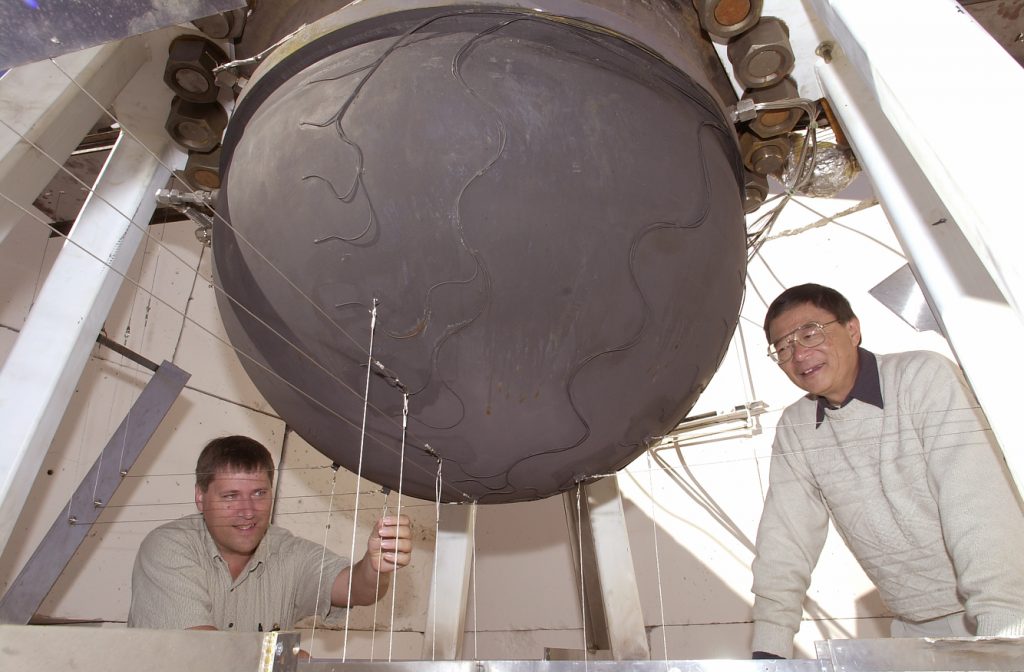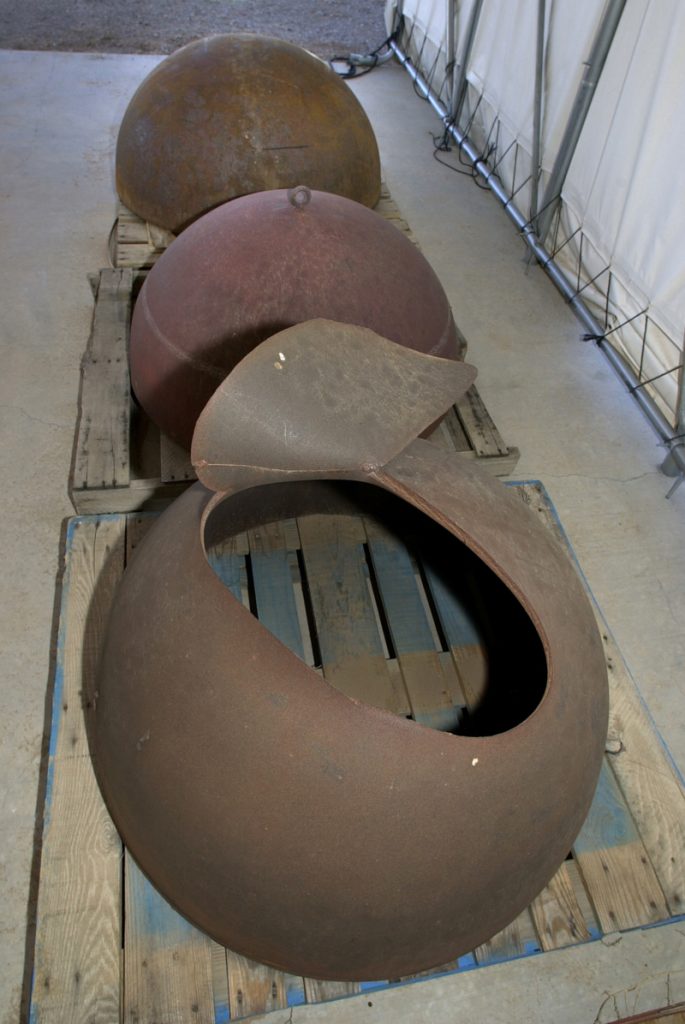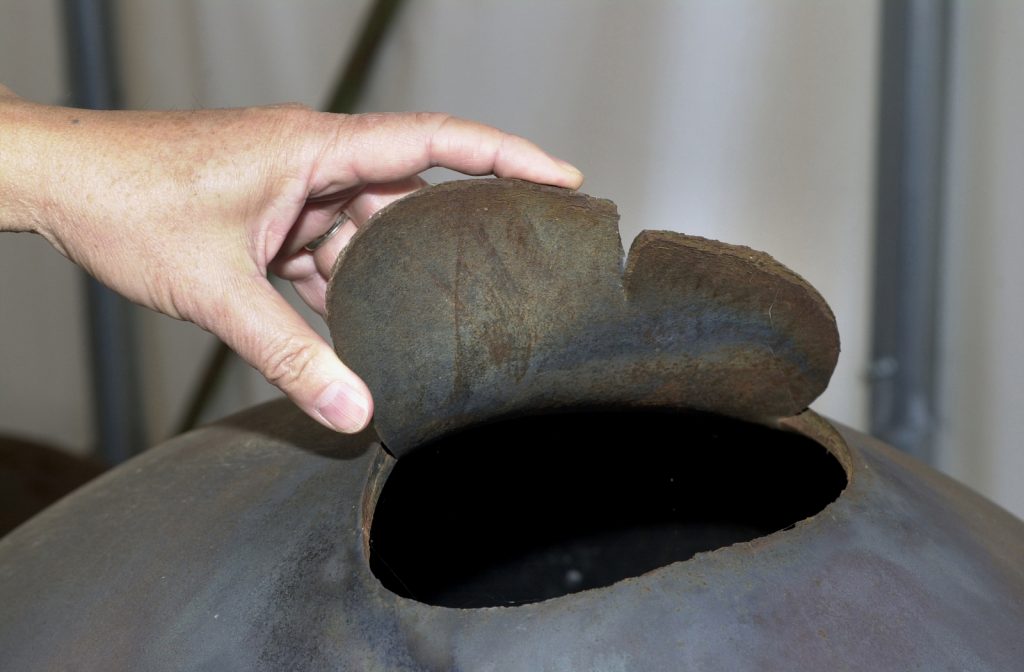![[nuclear reactor test]](https://www.sandia.gov/app/uploads/sites/81/2021/06/nuke1_pix.gif)
In the unlikely event of a severe nuclear power plant accident such as a core meltdown, the cylindrical steel pressure vessel that houses the reactor’s nuclear fuel rods would be subjected to extremely high temperatures and internal pressures, perhaps enough to rupture the vessel.
Last week Labs test engineers pushed a model of a critical component of such safety vessels — called a lower-head assembly — to its limits to better understand the materials properties and structural factors at work in serious nuclear reactor accidents.
Ken Reil, Manager of Nuclear Safety Testing Dept. 6423, hopes the tests will lead to improved predictive models so operators of nuclear plants would have better information if they needed to take measures to allay an accident, and designers of future plants would have the best possible safety features available.
Remarkable strength
On Monday, Oct. 23, Sandia test engineers pressurized the 1/5-scale model of a lower-head assembly (the inverted steel dome that would hold the damaged fuel during a partial or full core meltdown) to about 770 psi, then increased the temperature until the assembly stretched like a balloon and finally burst.
During the test, which lasted about four hours, the vessel’s steel turned red-hot and began to deform as it was gradually heated to internal temperatures exceeding 1800 Kelvin (2,780 degrees Fahrenheit).

At these temperatures and pressures, the vessel expands until its steel ruptures and energetically releases the internal pressure. The 3-inch-thick steel was thinned to a knife’s edge at some places. The 1-meter-diameter dome expanded by more than 11 centimeters at the spot of the rupture. Pieces of the graphite heater assembly were blown out through the hole and some were found more than 10 meters away from the Area 3 bunker where the test was conducted.
“These tests are very impressive to watch,” says co-principal investigator Larry Humphries (6423). “The strength of the steel even under these conditions is remarkable. As the assembly reached higher temperatures, its outer surface began to emit a red glow, which was quite dramatic as sunset approached. There was a loud bang when it failed.”
The researchers monitored the steel’s reaction to the heat and pressure using more than 100 sensors and video cameras, looking for material responses such as deformation, wall thinning, and hot spots, he says.
They’ll compare the test data to the materials response predicted by existing computer codes and materials failure models developed at Sandia and elsewhere.

A key technical issue in the test was the temperature difference between the vessel’s inner and outer surfaces. In a real nuclear reactor accident, this temperature difference could put severe strains on the steel’s structure, challenging the capabilities of the analytical models, he says.
“You can end up with a 200- to 400-degree difference,” he says. “We wanted to know more about that phenomenon.”
Test two of five
The test was the second of five Sandia tests planned during the next two years, all sponsored by the Organization for Economic Cooperation and Development (OECD). Eight OECD countries are providing the funding — Germany, France, Sweden, Finland, Spain, Belgium, the Czech Republic, and the US. The US support is provided by the Nuclear Regulatory Commission (NRC) and DOE.
Each of the tests puts a 1/5-scale-model lower-head assembly through a different temperature and pressure history that is representative of the conditions a vessel might experience in a distinct type of accident or accident-response scenario.
“We’re not trying to simulate an accident scenario,” says Ken. “We’re trying to put the vessel through the loads you might see to better understand, for instance, what happens if the plant operator injects water into the vessel to cool the core after a meltdown.”

“What we learn should help improve the industry’s models that predict structural behavior of the vessels so that a utility would know what to tell the plant operator to do in an accident,” he adds. “It also should help regulators better define the real margins of safety.”
Other Sandians involved in the tests include co-principal investigator T.Y. Chu (9100), John Bentz, Richard Simpson, Chuck Hanks (all 6423), Mark Nissen (9134), and Jeff Smith (6420). Martin Pilch (now 9133) conceived the experiment.
“These guys have done a great job of getting all the conditions right and measuring those conditions and the vessel’s response so we can test the materials modeling assumptions we are looking for,” adds Ken. “That’s not easy to do at these scales.”
Last modified: November 3, 2000